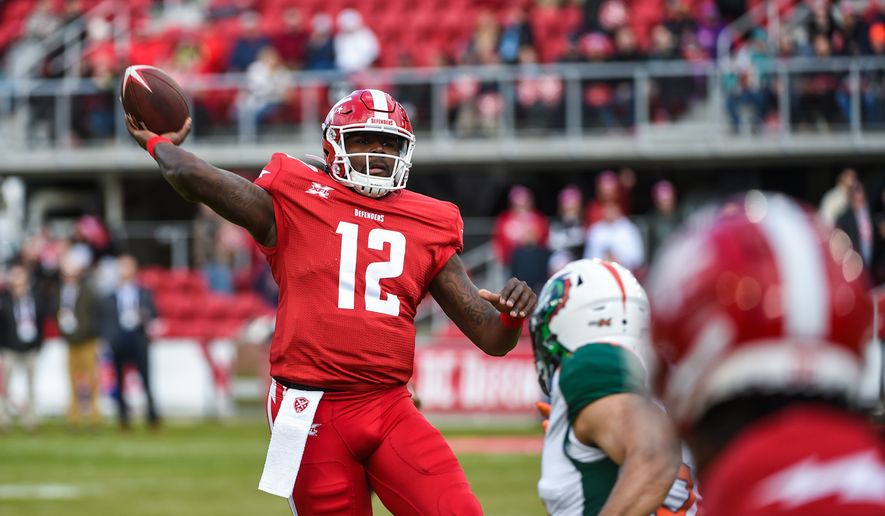The new-look XFL debuted last weekend with games in the District, Houston, New Jersey and Dallas. Some of the league’s tweaked rules were in play for the first time, from a faster 25-second play clock to kickoffs where special teamers lined up five yards apart and couldn’t run at one another until the returner caught the ball.
Here’s one “innovation” fans didn’t get to see in action: a 3-point conversion.
No XFL team attempted a 3-point try after a touchdown in Week 1 of the season, and coaches admitted they’re going to need more time to figure out the right way to utilize the three options at their disposal.
“That’s one area for certain that I know that we’re gonna clean up and do a better job at: game-planning and strategizing the point-after opportunities,” DC Defenders coach Pep Hamilton said.
In an effort to cut down on football set pieces fans consider boring, the XFL eliminated point-after kicks, which commissioner Oliver Luck has called “a fait accompli.” NFL kickers made about 94% of point-after tries in the 2019 season.
In their place, the league invented a three-tiered system: An offense can score one extra point by reaching the end zone from the 2-yard line, two points if they score from the 5-yard line or three points from the 10.
The system could incentivize teams to gamble for the highest reward, but not in Week 1. XFL teams combined for 19 touchdowns in the season’s opening weekend and converted point-after plays just seven times: 4-for-11 on 1-point tries and 3-for-8 on 2-pointers.
The Defenders went for two after their first touchdown Saturday but failed to convert. After that, they stuck to 1-point tries and went 1-for-3. They tried letting quarterback Cardale Jones or 6-foot-7 backup quarterback Tyree Jackson scramble out of the pocket, setting up the option to either run or pass to reach the goal line — but it never worked. Only a handoff to running back Donnel Pumphrey succeeded.
“Sometimes I feel like we could have kept it simpler in terms of just forcing them to stop us from just running the football,” Hamilton said. “Part of the plan was to get Tyree Jackson in in those situations and add a plus-1 runner, but (Seattle) did a good job at scheming it, bringing pressure off the overside edge and forcing him to pull the ball when there was nowhere to go. So I’ve gotta do a better job of coming up with plays and strategies to help us in those situations.”
Seattle Dragons coach Jim Zorn joked that “all the other coaches are much smarter than I am,” but agreed that the new rule adds a layer of strategy teams must get comfortable with.
“You’ve gotta really have confidence in what your plan is from the 10-yard line, then the 5-yard line,” Zorn said. “That’s why you probably saw more 1-point tries than deepening those tries up. They do become less likely, if you will, especially from the 10.”
Seattle trailed the Defenders by 12 in the fourth quarter of Saturday’s game, and had the Dragons scored one more touchdown, Zorn confirmed he would have wanted his team to go for three. A 9-point touchdown there would have brought the Dragons within a field goal with time winding down.
Analytics heads on social media agreed that 2-point tries provide the best bang for your buck. Teams have a bit more space from the 5-yard line to run a passing play if they want, while still being much shorter than a 10-yard attempt.
NFL analyst Warren Sharp pointed out that XFL coaches were given a point-after scenario chart explaining the optimal choice based on the game’s scoring margin and time remaining in the game. It’s reminiscent of when the NFL introduced 2-point conversions in 1994: Dick Vermeil drew up a chart for coaches to consult that explained when it made sense to go for two.
That took coaches some getting used to. Perhaps with some time, XFL teams will be ready give the 3-point conversion a shot.
• Adam Zielonka can be reached at azielonka@washingtontimes.com.




Please read our comment policy before commenting.